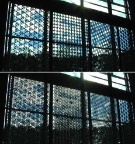Nov 16 2010
At the 2010 Greenbuild Expo, A. Zahner Company (Zahner) and Adaptive Building Initiative (ABI) have partnered to unveil Tessellate™, the latest adaptive façade system of ABI’s Intelligent Surfaces™ platform.
Intelligent Surfaces™ are kinetic façade systems which physically adapt to changes in daylight, solar gain, airflow, and privacy by altering their configuration. The latest product, Tessellate™, is a self-contained, framed screen whose perforated pattern can continually shift and evolve; creating a dynamic architectural element. It is designed for glass and glazing systems, walls, and dividers as a versatile, multi-purpose façade.
 Tessellate at SUNY Stony Brook's Simons Center for Geometry and Physics
Tessellate at SUNY Stony Brook's Simons Center for Geometry and Physics
Tessellate™ consists of stacked panels that can be constructed using various materials. Overlapping layers result in a kaleidoscopic visual display of patterns that align and then diverge into a fine, light-diffusing mesh. Geometry can range from regular grids to free-form patterns and panels can be constructed in any shape. Tessellate™ can be customized to fit any architectural vision—the options are virtually endless.
ABI, a joint venture of Hoberman Associates and Buro Happold, is a worldwide industry leader in the design, engineering, and integration of complex architectural structures and systems. Partnering with Zahner has solidified ABI’s full-service delivery of complete solutions for the building envelope. Craig Schwitter, Buro Happold Partner and co-founder of ABI, remarked: “We are very excited about this partnership. Zahner brings vast knowledge of metallurgy, of manufacturing, and of cladding technology to ABI. Combined with ABI’s deep understanding of building dynamics, integrated controls, and of kinetic cladding systems, we are well positioned to realize a new generation of adaptive façades.”
Committed to producing the architect’s vision, Zahner is responsible for many of the greatest architectural achievements of the late 20th century, including buildings designed by architects Frank Gehry, Zaha Hadid, Tadao Ando, and others. "Architects and artists have changed the way we think at our company," says Zahner president Bill Zahner. "Our reputation is built upon delivering not just a product that works, but a product that looks stunning, a product that changes the way people think. This is what we're doing with Tessellate™."
Tessellate™ is controlled using location-based sensory data to respond to light and weather conditions and fully integrates into the building management system. For instance, when high levels of direct light are detected, the metal panels diverge, and their patterns completely overlap, blocking the sun’s rays. The sensors are programmed in a variety of ways to maximize energy efficiency and savings.
Solar shading, Tessellate’s™ primary function, is an important consideration when designing an energy-efficient building envelope. It is a significant design challenge to reduce a building’s energy consumption while maintaining daylight levels that preserve views and promote a healthy internal environment.
Tessellate’s™ ability to shade adaptively addresses these concerns and improves a building’s energy performance by dynamically adjusting to environmental conditions and internal user preferences. More specifically, Tessellate™ provides the following energy savings:
- Applying Tessellate™ to the building envelope can reduce overall energy consumption by 6%.
- Tessellate™ can reduce a building’s annual cooling load by 15-20% over fixed shading.
- Due to its automated, adaptive response to external light levels, Tessellate™ can provide 12-14% more hours per year when day-lighting systems can be used over artificial lights, as compared to fixed shading or traditional blinds.
- When applied to a glass façade Tessellate™ allows glass with higher daylight transmission and improved color rendering capabilities to be specified while meeting or exceeding ASHRAE 90.1 2010 SHGC values.
Source: http://www.azahner.com